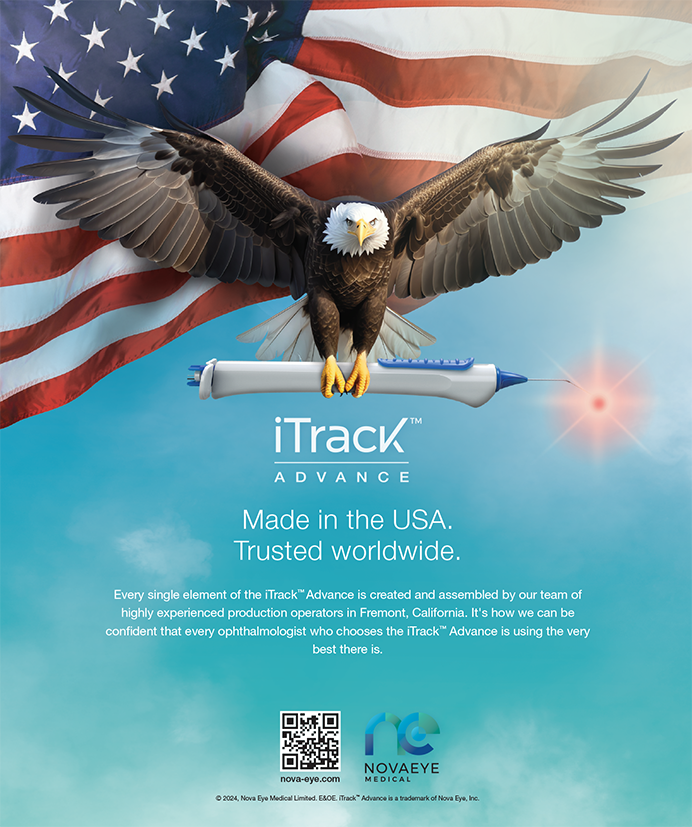

Refractive Outcomes After DMEK: Meta-analysis
Augustin VA, Son HS, Yildirim TM, et al1
Industry support: Multiple authors disclosed relationships with industry
ABSTRACT SUMMARY
A review of the literature on refractive outcomes analyzed the extent and causes of a refractive shift following Descemet membrane endothelial keratoplasty (DMEK). The PubMed library was searched for articles containing the terms Descemet membrane endothelial keratoplasty, DMEK, Descemet membrane endothelial keratoplasty combined with cataract surgery, and triple-DMEK, each paired with the keywords refractive shift, refractive outcomes, and hyperopic shift. Of the 127 studies identified, 98 were excluded based on criteria such as fewer than 25 DMEK cases; histopathologic/laboratory studies; cases of re-DMEK, DMEK combined with refractive procedures, and DMEK after penetrating keratoplasty; and review articles, letters, or editorials.
Study in Brief
A meta-analysis and literature review focused on refractive outcomes following Descemet membrane endothelial keratoplasty (DMEK). The overall mean change in spherical equivalent was a +0.43 D (95% CI, 0.31–0.55) hyperopic shift for all studies included in the meta-analysis. The study authors recommended a target refraction of -0.50 D when calculating IOL power in patients with Fuchs endothelial dystrophy, whether cataract surgery is performed as a standalone procedure or in combination with DMEK.
WHY IT MATTERS
DMEK can cause a refractive shift that is difficult to predict preoperatively. This meta-analysis and literature review provides valuable information on the extent and causes of postoperative changes in refraction.
The meta-analysis ultimately included 29 studies. The mean refractive outcome was +0.43 D (95% CI, 0.31–0.55), with 27 of the studies finding a hyperopic shift after DMEK. The postoperative shift was between 0 and +0.50 D in 19 studies, +0.50 and +1.00 D in six studies, and greater than +1.00 D in one study.
DISCUSSION
Although approximately 66% of the 29 studies reported a hyperopic shift of between 0 and +0.50 D, 93% and 62% of the studies included in the meta-analysis showed a standard deviation that was greater than +0.50 D and +1.00 D, respectively. Augustin and colleagues attributed this variability to the unpredictability of refractive changes because most of the studies included were retrospective and single-center analyses.
The net hyperopic shift appeared to result from a postoperative reduction in stromal swelling, which steepened the posterior corneal curvature.
The Pentacam (Oculus Optikgeräte) Q value can be used preoperatively to calculate the risk of a hyperopic shift after DMEK. The Q value indicates the corneal surface profile. Most healthy corneas are prolate (negative Q value), and edematous corneas are generally oblate (positive Q value). A spherical cornea has a Q value of zero. One study included in the meta-analysis examined 112 eyes with Fuchs endothelial corneal dystrophy that underwent triple DMEK and found that 60% of eyes with a positive Q value experienced a hyperopic shift postoperatively.
The meta-analysis by Augustin et al suggests that taking posterior and anterior curvature into account could improve refractive accuracy after DMEK. To achieve emmetropia in patients undergoing cataract surgery either before or in combination with DMEK, the study authors recommended a target refraction of -0.50 D.
Hitting the Refractive Target in Corneal Endothelial Transplantation Triple Procedures: a Systematic Review
Giglio R, Vinciguerra AL, Grotto A, Milan S, Tognetto D2
Industry support: None
ABSTRACT SUMMARY
A review article analyzed the mechanisms behind hyperopic outcomes after the triple procedure (phacoemulsification, IOL implantation, and endothelial transplantation) in patients with cataracts and Fuchs endothelial dystrophy. The investigators also sought to identify predictive risk factors for poor refractive outcomes as well as the ideal target refraction and IOL calculation methods for this patient population.
Study in Brief
A systematic literature review sought to identify the mechanism behind hyperopic outcomes after the triple procedure (phacoemulsification, IOL implantation, and endothelial keratoplasty). An optimal refractive target was not identified, but most surgeons targeted slight myopia.
WHY IT MATTERS
An ideal methodology for refractive targeting in patients undergoing the triple procedure would improve postoperative outcomes.
A total of 407 articles were analyzed, 18 of which were included in the study. No optimal target was identified, but the most common target refraction was between -0.50 and -0.75 D. Hyperopic surprises were more common in eyes with corneas that were flatter in the center than the periphery. No preferred IOL calculation formula was identified.
DISCUSSION
Given the heterogeneity of the data and study designs, data synthesis was not possible, so a qualitative review was completed of the 18 studies included. Triple procedures combining endothelial keratoplasty with cataract surgery offer the advantages of a single-stage operation, reduced risk, and lower cost. Changes induced by the graft, however, make accurate IOL power calculations challenging.
Giglio et al found hyperopic outcomes to be linked primarily to the effects of the endothelial graft rather than cataract surgery. Postoperative hyperopic shifts were associated with changes in corneal power and geometry as well as the diameter of the graft. Additionally, posterior corneal astigmatism sometimes increased after surgery because of factors such as graft decentering. The relationship between peripheral and central corneal geometry was found to play a significant role in postoperative refractive outcomes.
Debellemanière et al proposed distinguishing between DMEK-induced refractive shifts and IOL calculation errors because factors such as anterior and posterior corneal curvature contribute to both.3
Lamellar endothelial corneal grafts are becoming more prevalent. Emerging challenges include ensuring tissue consistency and reducing complications such as graft separation. Although eye banks can increase consistency by providing prestripped or preloaded tissue, research is necessary to compare outcomes between surgeon-prepared and eye bank–prepared tissues.
Despite efforts to refine techniques, there is no consensus on the degree of hyperopic shift expected after surgery or which patient subgroups are most affected. Surgeons therefore generally target -0.50 to -0.75 D of myopia. Prospective randomized studies are needed to improve IOL calculations for patients undergoing triple procedures.
1. Augustin VA, Son HS, Yildirim TM, et al. Refractive outcomes after DMEK: meta-analysis. J Cataract Refract Surg. 2023;49(9):982-987.
2. Giglio R, Vinciguerra AL, Grotto A, Milan S, Tognetto D. Hitting the refractive target in corneal endothelial transplantation triple procedures: a systematic review. Surv Ophthalmol. 2024;69(3):427-434.
3. Debellemanière G, Ghazal W, Dubois M, et al. Descemet membrane endothelial keratoplasty-induced refractive shift and Descemet membrane endothelial keratoplasty-induced intraocular lens calculation error. Cornea. 2023;42(8):954-961.




